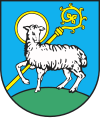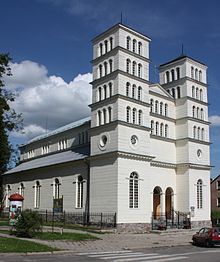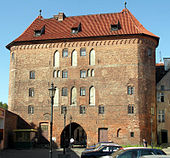Lidzbark Warmiński
| Lidzbark Warmiński | ||
|---|---|---|

|
|
|
| Basic data | ||
| State : | Poland | |
| Voivodeship : | Warmia-Masuria | |
| Powiat : | Lidzbarski | |
| Area : | 14.34 km² | |
| Geographic location : | 54 ° 7 ′ N , 20 ° 35 ′ E | |
| Height : | 65 m npm | |
| Residents : | 15,728 (Jun. 30, 2019) |
|
| Postal code : | 11-100 to 11-102 | |
| Telephone code : | (+48) 89 | |
| License plate : | NLI | |
| Economy and Transport | ||
| Street : | DK 51 | |
| Olsztyn - Bartoszyce | ||
| Next international airport : | Olsztyn-Mazury | |
| Gmina | ||
| Gminatype: | Borough | |
| Surface: | 14.34 km² | |
| Residents: | 15,728 (Jun. 30, 2019) |
|
| Population density : | 1097 inhabitants / km² | |
| Community number ( GUS ): | 2809011 | |
| Administration (as of 2015) | ||
| Mayor : | Jacek Wiśniowski | |
| Address: | ul.Ratuszowa 5 11-100 Lidzbark Warmiński |
|
| Website : | www.lidzbarkwarminski.pl | |
Lidzbark Warmiński [ 'lʲidzbark var'miɲskʲi ] ( German Heilsberg ) is a district town with 16,000 inhabitants in the Polish Warmian-Masurian Voivodeship .
Geographical location
The city is located in the former East Prussia , about 48 kilometers north of Olsztyn (Allenstein) at the confluence of the Symsarna (Simser) in the Łyna (Alle) .
history
Heilsberg was founded in 1240 by the Teutonic Order on the site of the Prussian Leckbard Castle, which was located at the point where the Simser flows into the Alley (the parts of the name lekes and bart literally mean oat chaff or to rise, flow or flow). Leckbard was taken by the Knights of the Order in 1241, but was recaptured by the Prussians in the second Prussian uprising in 1260/74.
Heilsberg became the seat of the Principality of Warmia in 1306 , one of the four dioceses established in the Prussian monastic state in 1243. In 1308 it received city rights from Bishop Eberhard von Neisse and remained in the territory of the Principality of Warmia for 500 years . The expansion of the bishop's domicile began around 1350. The Palace of the Bishops of Warmia was built on a square plan over the next half century. In the absence of the bishop, the castle burned down to the walls in 1442, so that the roof and gable collapsed and had to be replaced.
An alliance of neutrality had existed between the order and the prince-bishopric, but this was broken by the Ermländer during the Thirteen Years' War , as many of them now fought on the side of the renegade Prussian League . As a result, the Order's war with Poland was now also fought on Warmia and the Polish King Casimir IV. Andrew was given the opportunity to seize the Warmia castles. The handover of Heilsberg Castle in 1454, right at the beginning of the war, took place unsolicited by the cathedral chapter in the absence of Prince-Bishop Franz Kuhschmalz , who had been on a legation trip to Emperor Friedrich III since 1453 on behalf of Grand Master Konrad von Erlichshausen . found.
After the Second Peace of Thorne , Heilsberg came to the autonomous Prussian Royal Share in 1466 together with the Duchy of Warmia , which had voluntarily submitted to the sovereignty of the Polish crown. The principality, which was treated as a voivodeship there , was now exposed to attempts at polonization , which went hand in hand with the endeavor to convert the autonomous region into a Polish province if possible. On the occasion of the establishment of the Union of Lublin in the Lublin Sejm incorporated King Sigismund August. II on March 16 In 1569 the Royal Prussian share as a province formally in the Kingdom of Poland. The Warmia was able to retain large parts of its traditional local rights and privileges.
The Swedish King Charles XII resided in the winter of 1703/1704 . during his campaign against Poland and Russia in the Great Northern War in Heilsberg Castle, also known as the castle .
As part of the first division of Poland in 1772, Heilsberg came to the Kingdom of Prussia . From June 10th to 11th, 1807, the Battle of Heilsberg between French troops under Murat and Soult and the allied Russian and Prussian armies under Bennigsen took place here. At the beginning of the 20th century Heilsberg had a Protestant church, a Catholic church, a synagogue , an old episcopal castle that housed the St. Joseph Stift with orphanage, an agricultural winter school, a Catherine's monastery and a district court.
Heilsberg was the location of the medium wave transmitter Heilsberg from 1930 to 1945 . On May 27, 1937, riots broke out in Heilsberg after some members of the Catholic youth had been arrested during the Corpus Christi procession .
From 1818 to 1945 Heilsberg was the county seat of county Heilsberg in Administrative district Königsberg the province of East Prussia of the German Reich .
Towards the end of the Second World War , the Red Army occupied Heilsberg in the spring of 1945 . Although the city survived the invasion unscathed, it was set in flames a few days later. More than 40 percent of the city's building structure was destroyed. In the summer of 1945, the Heilsberg district and the southern half of East Prussia were placed under Polish administration by the Soviet occupying forces . The Polish place name Lidzbark Warmiński was introduced for Heilsberg . The immigration of Polish civilians began, some of whom came from the areas east of the Curzon Line that had fallen to the Soviet Union as part of the “ West displacement of Poland ” . The remaining German population was largely expelled from Heilsberg by the local Polish administrative authority .
Population development until 1945
| year | Residents | Remarks |
|---|---|---|
| 1782 | over 3,200 | |
| 1802 | 2,237 | |
| 1810 | 2,426 | |
| 1816 | 2,984 | including 471 Evangelicals, 2,437 Catholics and 76 Jews |
| 1821 | 3,433 | |
| 1831 | 4.216 | |
| 1852 | 4,781 | |
| 1858 | 5.105 | of which 830 Protestants, 4,126 Catholics and 149 Jews |
| 1871 | 5,839 | including 900 Protestants and 150 Jews |
| 1875 | 5,762 | |
| 1880 | 5,874 | |
| 1890 | 5,501 | 665 Protestants, 4,723 Catholics and 112 Jews |
| 1900 | 5,541 | mostly Catholics |
| 1910 | 6,082 | |
| 1933 | 8,781 | |
| 1939 | 10,630 | thereof 2,064 Protestants, 8,433 Catholics, seven other Christians and 15 Jews |
- Population development since 1945
The population of Lidzbark Warmiński by territory:
| year | Residents |
|---|---|
| 1971 | 13,000 |
| 1995 | 16,681 |
| 2000 | 16,505 |
| 2005 | 16,251 |
Cityscape
Located in a loop of the alley, the city was considered one of the most beautiful in East Prussia until 1945 . Despite the city fire after the war, some valuable buildings have been preserved or reconstructed. The Heilsberg castle of the Warmia bishops ( Hochschloss ) is considered to be the best-preserved fortification of the order times next to the Marienburg , it has served as a museum since the end of the 20th century. The greatest merit in maintaining the castle complex goes to Ferdinand von Quast and Karl Hauke.
Other striking buildings are the late Gothic parish church and the Hohe Tor. When it was completed in 1400, the church was laid out as a three-aisled basilica without a choir . After the side aisles were raised in 1497, a hall church was built . Some historic streets, including a row of the characteristic arbor houses on the market square, have also stood the test of time. The first Protestant church in the former Warmian dominion was built in 1823 according to plans by Karl Friedrich Schinkel (now Polish Orthodox ).
Religions

After the Reformation , Catholicism continued to prevail in Heilsberg . In 1890 there were 665 Evangelicals, 4,723 Catholics and 112 Jews in the city. Most of the Poles who immigrated after the war were also Catholic. The previous Evangelical Church was taken over by the new Orthodox community.
The city's Catholic parish is today a partner parish of the Catholic parish of Werlte . This is probably due to the fact that the pastor of the Heilsberg congregation came to Werlte in 1945 as a displaced person and became a pastor there.
The church bell of St. Theodore (champion Michael Wittwerck , Gdansk 1716) of the Catholic Church of St. Peter and Paul was 1941/1942 drafted into the melting down for war purposes, superimposed on the Hamburg bell cemetery and after the Second World War to the Archbishopric in Freiburg to Hand over safekeeping. Today (2008) it is on loan at the East Prussian State Museum in Lüneburg.
Memorial to British prisoners of war who perished in World War I.
At the time of the First World War there was a prisoner of war camp near Heilsberg, where the German army interned mainly Russian prisoners of war. A small number of British prisoners were also housed in the camp. Between August and December 1918, 39 British soldiers died in the camp hospital. The prisoners of war fell ill in the overcrowded camp with very poor hygienic conditions, so that the last soldiers could not return to their homeland even after the end of the war and died there. The British soldiers were buried in the Lidzbark Warmiński War Cemetery , where around 2,800 prisoners were buried in unmarked mass graves. The cemetery on the north-eastern outskirts in the suburb Markajmy was maintained until the 1960s, but the increasing decline then led to its abandonment. In spring 2014, the Commonwealth War Graves Commission erected a new memorial in the old cemetery for the dead British soldiers who had been commemorated in the Malbork Commonwealth War Cemetery in Malbork .
Partner communities
- Oud-Beijerland , Netherlands - since June 26, 1992
- Milanówek , Poland - since October 25, 2001
- Kaliningrad , Russia - since May 3, 2001
- Werlte , Germany - since September 8, 2005
Lidzbark Warmiński is a member of the international association Cittàslow .
Rural community
The town is the seat of the Lidzbark Warmiński rural community , but it does not belong to it. It has 6,727 inhabitants (June 30, 2019) and has an area of 371 km² - 28% of which is covered by forest and 56% by agricultural area.
Personalities
sons and daughters of the town
- Eustachius von Knobelsdorff (1519–1571), German neo-Latin poet and epic poet
- Georg Heinrich Sappuhn (1659–1721), Protestant theologian, pastor and high school teacher in Slovakia and Germany
- Mathias Meyer (died 1737 in Heiligelinde ), baroque painter in Warmia, Prussia
- Wilhelm von Thümen (1792-1856), Prussian lieutenant general
- Xaver Frölich (1822–1898), city archivist in Graudenz and historian
- Anton Pohlmann (1829-1891), archpriest and member of the Reichstag (center)
- Ernst Burchard (1876–1920), German doctor and sexologist
- Bruno Hippler (1894–1942), German officer (major general)
- Bruno Kitt (1906–1946), SS-Hauptsturmführer and concentration camp doctor in the Auschwitz and Neuengamme concentration camps
- Arnold Döring (1918–2001), German officer, fighter pilot and knight's cross holder
- Alfred Penkert (1933–2019), German educator and non-fiction author
- Dorothee Rätsch (* 1940), German sculptor and graphic artist
- Gert Neumann (* 1942), German writer
- Doris Janssen-Reschke (1944–2008), German Lutheran theologian, regional superintendent of the Osnabrück district of the Evangelical Lutheran regional church of Hanover
- Tadeusz Płoski (1956–2010), Roman Catholic military bishop of the Polish armed forces and victim of the plane crash near Smolensk
- Adam Żyliński (* 1958), Polish politician
Other personalities
- Ferdinand Schulz (1892–1929), the “Icarus of East Prussia”, has his grave in the Heilsberg forest cemetery.
- Margarete Neumann (1917–2002), German writer and poet, lived in Heilsberg until 1945 and worked there as a welfare worker
Heilsberg in world literature
The Battle of Preussisch Eylau (1807) is the starting point of Balzac's famous story Le Colonel Chabert from 1832. The title hero is seriously wounded as a colonel near Eylau, buried alive in a mass grave and rescued by a Heilsberg farmer's wife.
literature
- Johann Friedrich Goldbeck : Complete topography of the Kingdom of Prussia . Part I: Topography of East Prussia . Königsberg / Leipzig 1785, p. 22, item VI.
- August Eduard Preuss : Prussian country and folklore or description of Prussia. A manual for primary school teachers in the province of Prussia, as well as for all friends of the fatherland . Bornträger Brothers, Königsberg 1835, pp. 511–512, no. 106.
- Carl Nietzki: The Heilsberg Castle . In: New Prussian Provincial Papers . Volume 5, Königsberg 1848, pp. 19-39 and pp. 104-117.
- Maria Biolik: tributaries to the Baltic Sea between the lower Vistula and Pregel . = Nazwy wodne dopływów Bałtyku między dolną Wisłą a Pregołą . Steiner-Verlag Wiesbaden, Stuttgart 1989, ISBN 3-515-05521-5 ( Hydronymia Europaea Lfg. 5).
- Alexander Kurschat: Lithuanian-German Dictionary. Thesaurus linguae lituanicae . 4 volumes. Vandenhoeck & Ruprecht, Göttingen 1968–1973.
- Vilius Peteraitis: Mažoji Lietuva ir Tvanksta . = Lithuania Minor and Tvanksta . Mažosios Lietuvos Fondas et al., Vilnius 1992 ( Mažosios Lietuvos Fondo leidiniai 2).
- Gerhard Salemke: Site plans of old Prussian ramparts in the former province of East Prussia , Gütersloh, 2005.
- Otto Schlüter : Forests, swamps and settlements in Old Prussia before the time of the order . Niemeyer, Halle 1921.
Web links
- Pictures from Heilsberg / Lidzbark Warmiński. Founding history as the city of the Teutonic Order
- History of Heilsberg with information for tourists
Individual evidence
- ↑ a b population. Size and Structure by Territorial Division. As of June 30, 2019. Główny Urząd Statystyczny (GUS) (PDF files; 0.99 MiB), accessed December 24, 2019 .
- ↑ City website (BIP), Kierownictwo Urzędu - Burmistrz , accessed on March 6, 2015.
- ^ A b c Carl Nietzki: The castle at Heilsberg . In: New Prussian Provincial Papers . Volume 5, Königsberg 1848, pp. 19-39 and pp. 104-117, in particular pp. 35 ff.
- ↑ a b Meyer's Large Conversation Lexicon . 6th edition, 9th volume, Leipzig and Vienna 1907, p. 79 .
- ^ Johann Friedrich Goldbeck : Complete topography of the Kingdom of Prussia . Part I: Topography of East Prussia . Marienwerder 1785, p. 22, item VI.
- ↑ a b c d Alexander August Mützell and Leopold Krug : New topographical-statistical-geographical dictionary of the Prussian state . Volume 5: T – Z , Halle 1823, pp. 298–299, item 253.
- ^ August Eduard Preuss : Prussian country and folklore or description of Prussia. A manual for primary school teachers in the province of Prussia, as well as for all friends of the fatherland . Bornträger Brothers, Königsberg 1835, p. 507, no. 98.
- ^ Kraatz: Topographical-statistical manual of the Prussian state . Berlin 1856, p. 229.
- ↑ Adolf Schlott: Topographical-statistical overview of the government district of Königsberg, based on official sources . Hartung, Königsberg 1861, p. 111.
- ^ Gustav Neumann: Geography of the Prussian State . 2nd edition, Volume 2, Berlin 1874, p. 19, item 14.
- ↑ a b c d e Michael Rademacher: German administrative history from the unification of the empire in 1871 to the reunification in 1990. Heilsberg.html. (Online material for the dissertation, Osnabrück 2006).
- ↑ http://meindeververzeichnis.de/gem1900//gem1900.htm?ostpreussen/heilsberg.htm ( page no longer available , search in web archives ) Info: The link was automatically marked as defective. Please check the link according to the instructions and then remove this notice.
- ^ Sources of population figures: 1971: Georg Hermanowski: Ostpreußen – Lexikon. Augsburg 1996 - 1995, 2000, 2005: stat.gov.pl
- ↑ See Michael Rademacher: German administrative history from the unification of the empire in 1871 to the reunification in 1990. Landkreis Heilsberg (Polish Lidzbark-Warminski). (Online material for the dissertation, Osnabrück 2006).
- ^ Lidzbark Warmiński War Cemetry Commonwealth War Graves Commission cemetery details , accessed May 18, 2014
- ↑ World War One Heilsberg prisoner of war cemetery restored on BBC News May 16, 2014, accessed May 18, 2014
- ↑ The 'Heilsberg 39': Remembering England's WW1 prisoners of war on BBC News, May 16, 2014, accessed May 18, 2014





